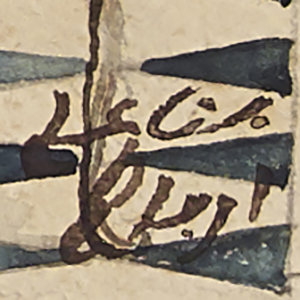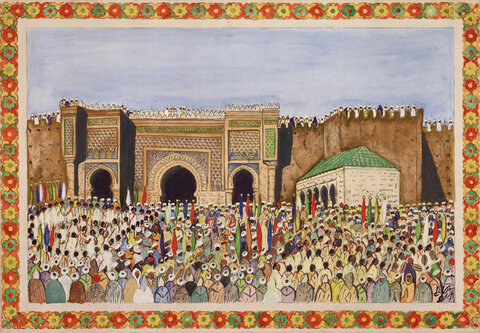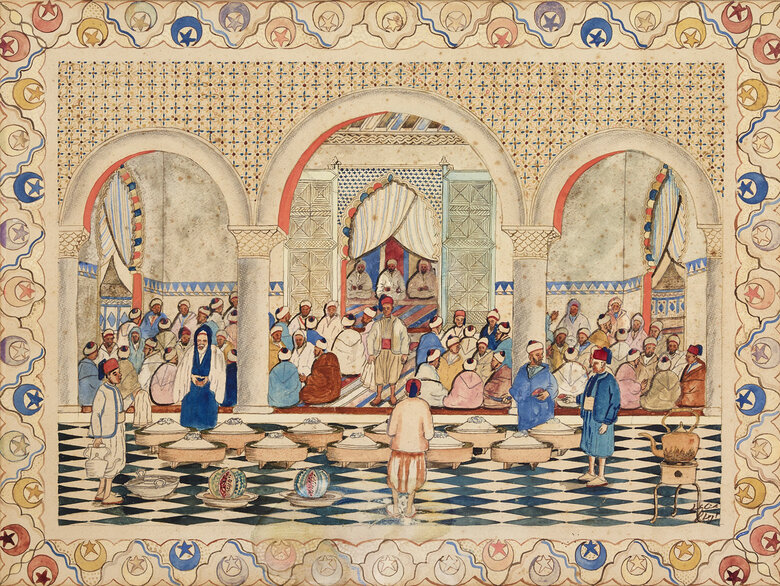Written by Arthur Debsi Born in Rabat in 1861, Mohamed Ben Ali Rbati relocated early to the city of Tangier in 1886. After briefly studying in Koranic schools, Rbati eventually became a carpenter....


MOHAMED BEN ALI RBATI, Morocco (1861 - 1939)
Bio
Written by Arthur Debsi
Born in Rabat in 1861, Mohamed Ben Ali Rbati relocated early to the city of Tangier in 1886. After briefly studying in Koranic schools, Rbati eventually became a carpenter. In 1903, he worked as a cook at the house of Sir John Lavery (1856-1941), an Irish painter of the British court. During spare time from working, Mohamed Ben Ali Rbati used to draw a lot in his bedroom, and his works caught the attention of Lavery, who encouraged his employee to pursue an artistic career. Then, Rbati traveled to Great Britain, where he exhibited for the first time at the Goupil Gallery in London in 1916. After the World War I, Mohamed Ben Ali Rbati went to Marseilles, in the south of France, where he presented his works a second time in 1919. Three years later, the artist came back to Tangier, but would really dedicate himself to painting as of 1933, when he eventually got his own atelier.
The artistic journey of Mohamed Ben Ali Rbati is related to the art activity in Morocco, which developed from the pre-colonial period to the French Protectorate in 1912. The country had always attracted European artists since the first half of the 19th century. Great masters such as French painter Eugène Delacroix (1798-1863), visited Morocco, where they especially found inspiration in the warm colors of the local landscapes. Later on, pioneer figures of French modern art movement like Henri Matisse (1869-1954) would be inspired by the luminosity, and the ornamental motifs of Islamic arts[1]. The stays of these European artists highly contributed to the introduction of Western art, and technique, namely easel painting[2], to Moroccan people. Back then, Mohamed Ben Ali Rbati belongs to the first generation of Moroccan painters, who were exposed to the paintings of the foreign artists established in the country.
When in Tangier, Mohamed Ben Ali Rabti was sensitive to the vibrant atmosphere of the city, full of all sorts of artisans, where the smells, and colors would carry him away. Throughout his lifetime, Rbati had also the chance to frequent the local upper class of the society. He was invited to all kind of gatherings, and ceremonies, even the ones for women; which enabled him to accurately illustrate scenes like in the two non-dated paintings entitled Banquet Après la Fête Religieuse, and Fête Arabe Devant Bab Mansour À Meknès, both part of the Dalloul Art Foundation’s collection. In the first painting, Mohamed Ben Ali Rbati depicted a gathering of men, occurring in a lavish Moroccan interior, and which seems to be a festive, most probably religious, occasion. In the second painting, the scene takes place in the old town of Meknes, in front of Bab Mansour. In both examples, all the present characters are wearing the traditional djellabas, and covered their heads with the red tarbush, or white turbans.
The colorful, and charming daily scenes in the paintings of Mohamed Ben Ali Rbati were used as illustrations in three national Moroccan postal stamps, in 1979, and 2013[3].
The entire oeuvre of Mohamed Ben Ali Rbati is a celebration of Moroccan culture, and also manifests his affiliation to the traditional Islamic painting. From a Muslim background, Rbati was an artist, who actually worked on figuration. This goes against the commonly held view, according to which Islam strictly bans figurations in the artistic production. In fact, Quran indicates that only worshipping idols, al-asnam, through a figurative image, or statues, is forbidden: ‘Ô croyants, le vin, les jeux de hasard, les idôles et les flèches divinatoires sont des abominations inventées par Satan, abstenez-vous en et vous serez heureux’[4]. Hence, the production of secular images is allowed, and this is how the art of miniature developed all around the Arab-Islamic world for centuries. Yet, Arabic miniature has its own aesthetics, and respond to specific technical rules, that Rbati seemed to have followed in the artwork Banquet Après la Fête Religieuse. Here, he applied flat colors, with no hues, and didn’t chose to employ a one-point perspective. He effectively overlapped the elements of the composition, and played with their dimensions, to create an impression of depth. Furthermore, the painter treated the canvas like the page of a manuscript, with a beige background, and illuminations, which shroud the animated scene with the Islamic crescents.
In his practice, Mohamed Ben Ali Rbati always paid extreme attention to details, especially in the reproduction of decorative motifs. And by including architectural elements in his paintings, he showed how he was able to combine both the dexterity of a carpenter, and the sharp eye of a painter. In the other non-dated artwork entitled Fête Arabe Devant Bab Mansour À Meknès, from the Dalloul Art Foundation’s collection, he again painted a celebration, where a crowd gather in front of the impressive Bab Mansour, or ‘the Gate of Mansour’ in Meknes. This gate was finalized in 1732 by Mulay Abdullah – one of the numerous children of Mulay Ismail Ben Sharif (1645-1727); and marks the front entrance of El-Hedim square. The edifice is emblematic of the architectural heritage in Morocco, and more precisely of the Moorish style, which had spread all over the Maghreb countries, as well as Al-Andalus, since the 8th century. Mohamed Ben Ali Rbati certainly took the time to observe the gate, and the techniques employed for its construction, in order to reproduce it meticulously in his canvas. Bab Mansour has the typical round horseshoe arch, and the complex décor in mosaic, called zellij. This mosaic technique consists in assembling hand-chiseled colored tiles with each other to form geometric motifs. Like in reality, Rbati painted in blue, and green colors the tiles, which shape floral elements, and arabesques, covering the façade. The artist also integrated the Koranic panels on the top of the gate, whose he perfectly rendered the faded condition.
Mohamed Ben Ali Rbati produced an oeuvre, which is fundamental in the art history of Morocco. It effectively demonstrates the appropriation of easel painting by a Muslim Moroccan painter, who would combine it with the traditional art practice of the Arabic miniature. On the other hand, Rbati freed his paintings from an Orientalist approach, adopted by the European painters. On the contrary, he left for posterity an authentic testimony of the daily life in Morocco in the 19th and 20th centuries.
Mohamed Ben Ali Rbati passed away in 1939.
[1] Peltre, Christine. ‘L’Étude des arts musulmans: une ‘création occidentale’ in Histoire de l’art et anthropologie, Paris, INHA, Branly Jacques Chirac (Les Actes), 2009. [P.1]
[2] Ali, Wijdan. Modern Islamic Art: Development and Continuity. Gainesville, USA: University Press of Florida, 1997. [P.72]
[3] Youdi. “Personalités Marocaines 2013 - Mohammed Ben Ali Rbati (1861-1939) - Timbres-Du-Maroc.” timbres, July 28, 2013.
[4] Quran (5:92): ‘ô Croyants, Intoxicants, gambling, idolatry, and divination are abominations of Satan’s doing. Avoid them, so that you may prosper’. French translation from Arabic in Beaugé Gilbert, and Clément Jean-François. L'Image Dans Le Monde Arabe. Paris, France: CNRS Editions, 1995. [P.14]
Sources
Ali, Wijdan. Modern Islamic Art: Development and Continuity. Gainesville, USA: University Press of Florida, 1997.
Aroussi, Moulim el., and Brahim Alaoui. Peinture Marocaine 1950-2010: Collection Elisabeth Bauchet-Bouhlal. Marrakech, Morocco: ES-SAADI Garden & Resort, 2010.
Beaugé Gilbert, and Clément Jean-François. L'Image Dans Le Monde Arabe. Paris, France: CNRS Editions, 1995.
Chraïbi Zineb. Mohammed Ben Ali R'bati Naissance De La Peinture Marocaine 1861-1936. Rabat, Morocco: Editions Marsam, 2007.
Eigner, Saeb. Art of the Middle-East, Modern and Contemporary Art of the Arab World and Iran. London, UK: Merell Publishers Limited, 2011.
Guesdon Marie-Geneviève, and Annie Nouri-Vernay. L'art Du Livre Arabe: Du Manuscrit Au Livre D'artiste. Paris, France: Bibliothèque nationale de France, 2001.
Marlène Lespes. De l’Orientalisme à l’art colonial: les peintres français au Maroc pendant le Protectorat (1912-1956). Art et histoire de l’art. Université Toulouse le Mirail - Toulouse II, 2017.
Papadopoulo, Alexandre. ‘Esthétique De L'art Musulman. La Peinture.’ in Annales. Histoires, Sciences sociales., Cambridge University Press: UK, no. 3 (1973): 681–710. https://www.jstor.org/stable/27579050.
Peltre, Christine. ‘L’Étude des arts musulmans: une ‘création occidentale’ in Histoire de l’art et anthropologie, Paris, INHA, Branly Jacques Chirac (Les Actes), 2009.
Youdi. “Personalités Marocaines 2013 - Mohammed Ben Ali Rbati (1861-1939) - Timbres-Du-Maroc.” timbres, July 28, 2013. http://www.timbres-du-maroc.info/blog/personalites-marocaines-2013-mohammed-ben-ali-rbati-1861-1939/.
CV
Selected Solo Exhibitions
2020
Les Peintres marocains dans les collections nationales, de Ben Ali R’bati à nos jours, Musée Mohammed VI d’Art Moderne et Contemporain, Rabat, Morocco
2014
Mohamed Ben Ali Rbati (1869-1939), Musée de la Fondation Slaoui, Casablanca, Morocco
1922
Mamounia Palace, Rabat, Morocco
1919
Marseille, France
1916
Goupil Gallery, London, United Kingdom
Selected Group Exhibitions
2014
Le Maroc aux mille couleurs, Institut du Monde Arabe, Paris, France
Collections
Mathaf: Arab Museum of Modern Art, Doha, Qatar
Bank Al-Maghrib Museum, Rabat, Morocco
Musée de la Fondation Slaoui, Casablanca, Morocco
Musée Mohammed VI d’Art Moderne et Contemporain, Rabat, Morocco
The Ramzi and Saeda Dalloul Art Foundation, Beirut, Lebanon
Press
Le Musée Abderrahman Slaoui - Exposition Mohamed Ben Ali R_bati (1869-1939), premier peintre figuratif marocain.pdf
مغرس _ الفنان التشكيلي محمد بن علي الرباطي _ بن علي الرباطي_ شاهد عصره على وقائع عرفها المغرب في القرن19.pdf
Mohammed Ben Ali Rbat- Timbres Du Maroc .pdf
محمد بن علي الرباطي عرّاب التشكيل المغربي 1 _ إطار فني.pdf
محمد بن علي الرباطي وحكاية الدخول لعالم الصورة.pdf
الفنان محمد بن علي الرباطي ما بين العالمية والإهمال.pdf
MOHAMED BEN ALI RBATI Artwork
Become a Member
Join us in our endless discovery of modern and contemporary Arab art
Become a Member
Get updates from DAF
Follow Artists
Save your favourite Artworks
Share your perspectives on Artworks
Be part of our community
It's Free!
We value your privacy
TermsCookiesPrivacy Policies
Become a Member
Get updates from DAF
Follow Artists
Save your favourite Artworks
Share your perspectives on Artworks
Be part of our community
It's Free!
We value your privacy
TermsCookiesPrivacy Policies
Become a Member
Get updates from DAF
Follow Artists
Save your favourite Artworks
Share your perspectives on Artworks
Be part of our community
It's Free!
We value your privacy
TermsCookiesPrivacy Policies
Welcome to the Dalloul Art Foundation
Thank you for joining our community
If you have entered your email to become a member of the Dalloul Art Foundation, please click the button below to confirm your email and agree to our Terms, Cookie & Privacy policies.
We value your privacy, see how
Become a Member
Get updates from DAF
Follow Artists
Save your favourite Artworks
Share your perspectives on Artworks
Be part of our community
It's Free!
We value your privacy
TermsCookiesPrivacy Policies






